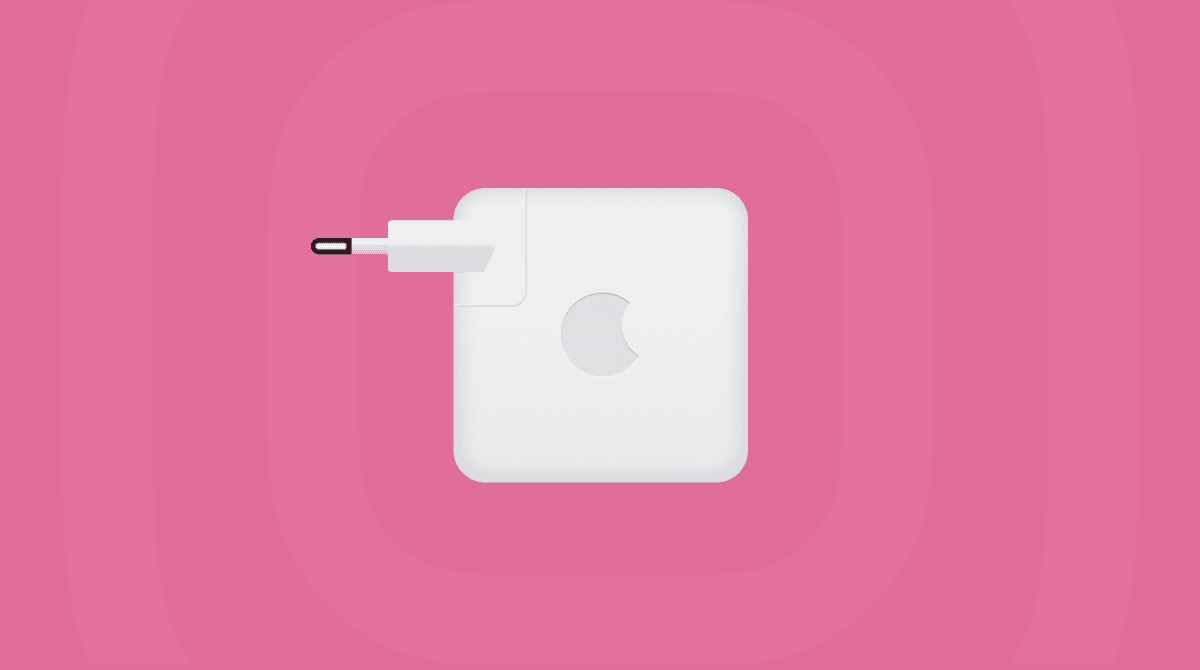Macs have become an important part of our everyday lives, as we use them for work, communication, and entertainment. In all of these cases, we need sound. If the sound on your Mac has stopped working, there are several possible explanations and solutions. The first thing to check is that the sound definitely is not working. Below, we’ll explain what to check and how to fix the annoying issue.
Why isn’t my sound working on my Mac
There are several causes of Mac sound not working. Here are the most common ones:
- You muted your Mac unintentionally
- Misconfigured settings
- Issues with connected peripherals
- Software glitches
No sound on Mac? Check these things first
1. Check the volume
As simplistic as it may seem, the first thing to check is that the volume hasn’t been muted unintentionally. Tap the volume up (F12) key to turn up the sound level.
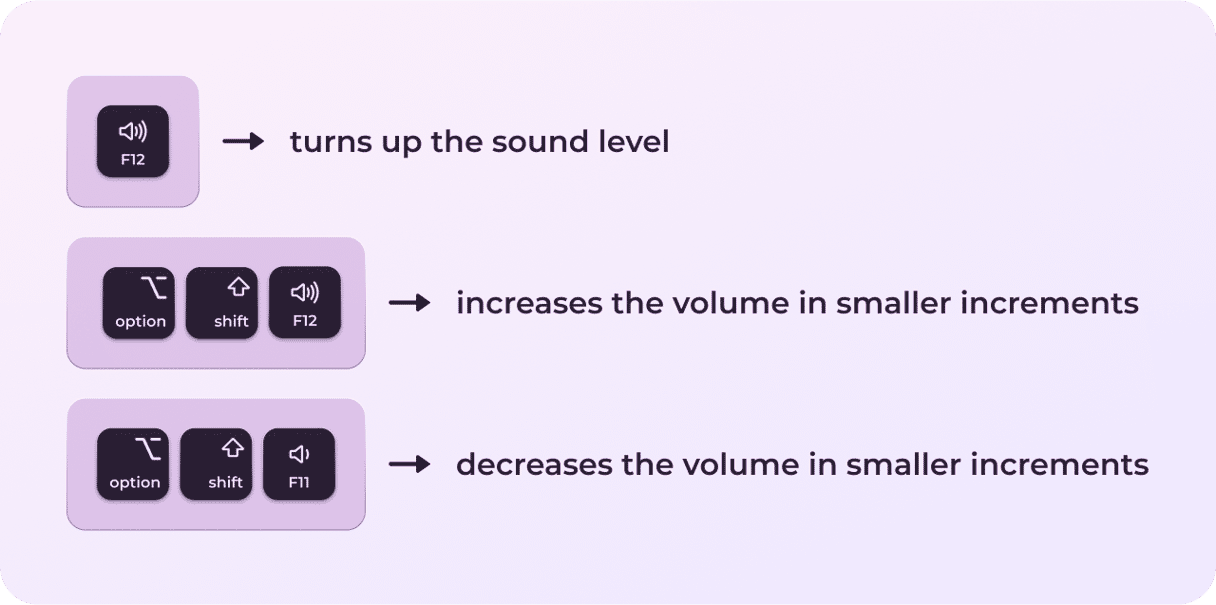
2. Check the output source and other settings
If you’ve made sure that sound isn’t working indeed, the first step is to check your Sound settings:
- Click on the Apple menu and select System Settings.
- Go to Sound.
- Select the Output tab and click built-in speakers. If that’s not available as an option, contact Apple Support.
- Check if the volume slider is low; if so, slide it to the right and recheck the sound.
- Make sure the Mute box under Output volume isn’t selected.
_1671815885.png)
3. Run Maintenance Scripts
If you’ve determined your Mac’s sound definitely isn’t working and checking System Settings hasn’t helped, consider running CleanMyMac and its tool called Performance. This is a popular control and care app for do-it-yourself Mac troubleshooting. What does the Performance feature do? It optimizes the performance of your Mac by running a number of routines, such as repairing disk permissions, reindexing Spotlight, and flushing DNS cache.
Here’s how to run maintenance tasks:
- Get your free CleanMyMac trial.
- Open the app.
- Click Performance and run a quick scan.
- Click Run Tasks. Alternatively, you can click View All Tasks if you want to select what to run.
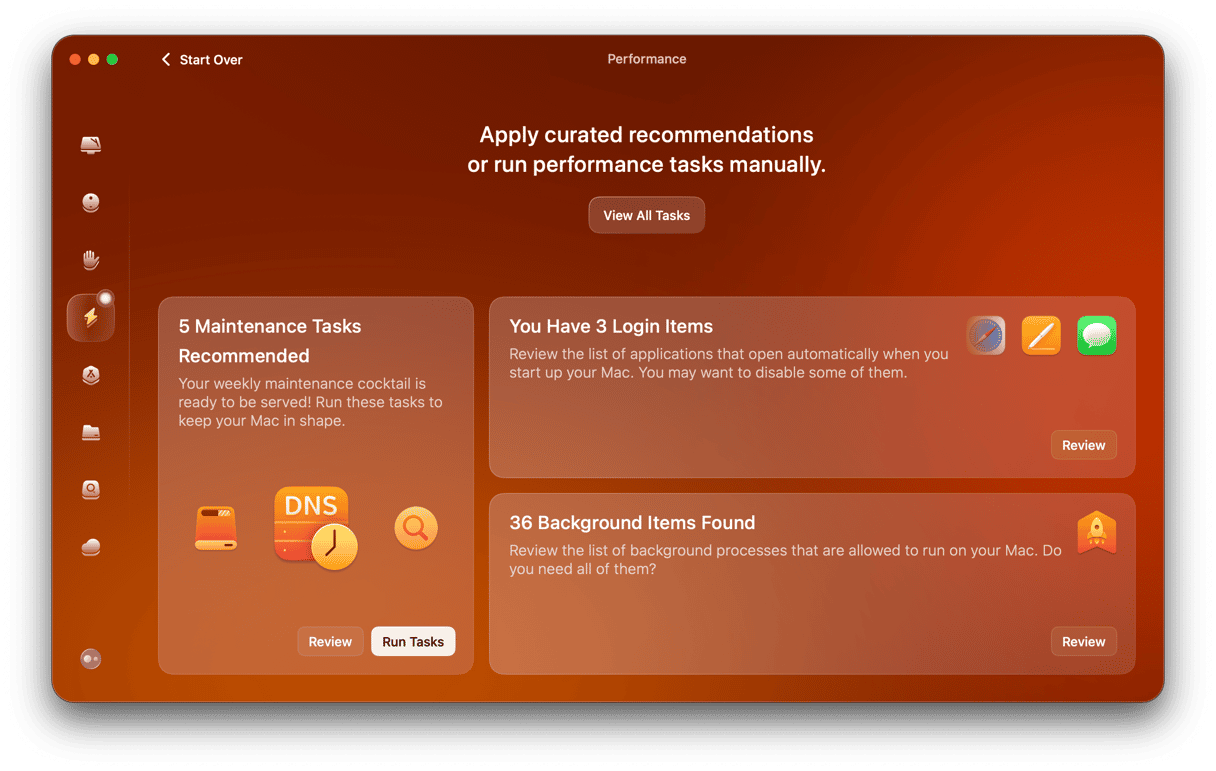
You can also use the Performance tool to control login items and background apps.
4. Unplug peripheral devices
If, when checking System Settings, you saw a USB device selected rather than built-in speakers and could not change it, disconnect all peripheral devices from your Mac and try again. These are devices connected via both USB and Bluetooth, such as headphones and speakers. They can stop the sound from coming out of the built-in speakers of your Mac.
5. Restart your Mac
Basically, it should be the first thing you do should you face any issues with your Mac. However, we all rarely do it because we do not like reopening the apps we use and browser tabs we open. Still, it can fix numerous small problems, and no sound on MacBook is one of them.
Just go to the Apple menu and click Restart. You may select the Reopen windows option.
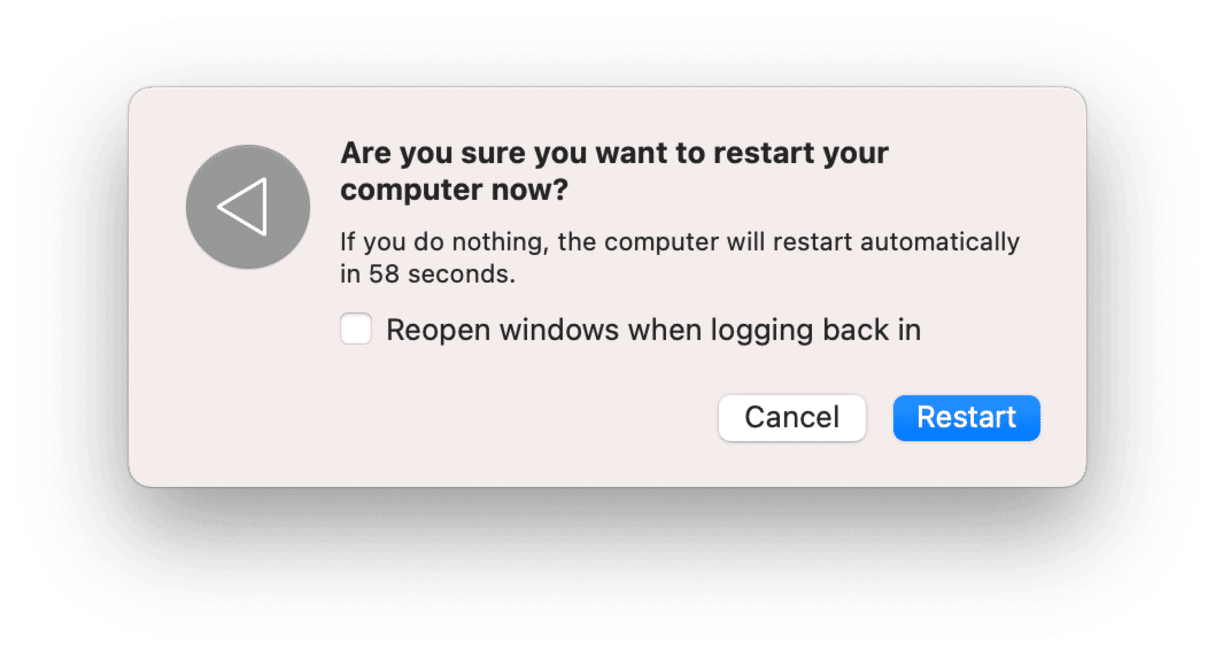
6. Update your macOS
If there’s still no sound on your Mac, Apple’s advice is that the first thing you should do is make sure you’re running the latest version of macOS.
To check which version of macOS your Mac is running, click the Apple menu and then About this Mac. The window that opens will have the name of the version of macOS currently installed. Now, the latest version is macOS Sonoma, so you should consider installing it by going to the App Store app and clicking Get in the sidebar on the right side of the main window.
If you don’t want to install Sonoma, at least make sure you’re running the latest update to whichever version of the OS is installed. To check that, go to System Settings > General > Software Update and see if an update is available. Make sure you choose the latest version of your current OS from the list of available updates. Click Install now and follow the on-screen instructions.

Before installing either a new version of the OS or an update, back up your Mac using Time Machine or whatever backup tool you normally use.
7. Reset the problematic app
It may be that there’s no sound on your Mac because it won’t play audio in a specific app. If, for example, you can’t hear sound from a video in Safari, make sure the audio isn’t muted by clicking the volume control in the video. You should also check other sound sources, like Music, TV, or QuickTime movies, to find out if they can play sound.
If you find out the MacBook sound not working issue occurs in a particular app, the best thing is to reset it. There are two options here. The first one is uninstalling the app and reinstalling it. The trick with this one is that simply dragging an app to the Trash will leave leftover files, and they may still interfere with the sound. More than that, some apps come preinstalled on your Mac, meaning that they cannot be uninstalled.
It is when the second option comes into play, and it is about using a dedicated third-party tool to do the job for you. CleanMyMac we’ve mentioned above comes with the Uninstaller module that can reset apps. By reset, we mean bringing it to the state in which it was once you first installed it on your computer.
Here’s how to reset apps with CleanMyMac:
- Open CleanMyMac.
- From the sidebar, navigate to Applications.
- Run a scan and click Manage My Applications > Uninstaller.
- Click the arrow next to the app you want to reset and select everything but Binaries.
- Click Remove.
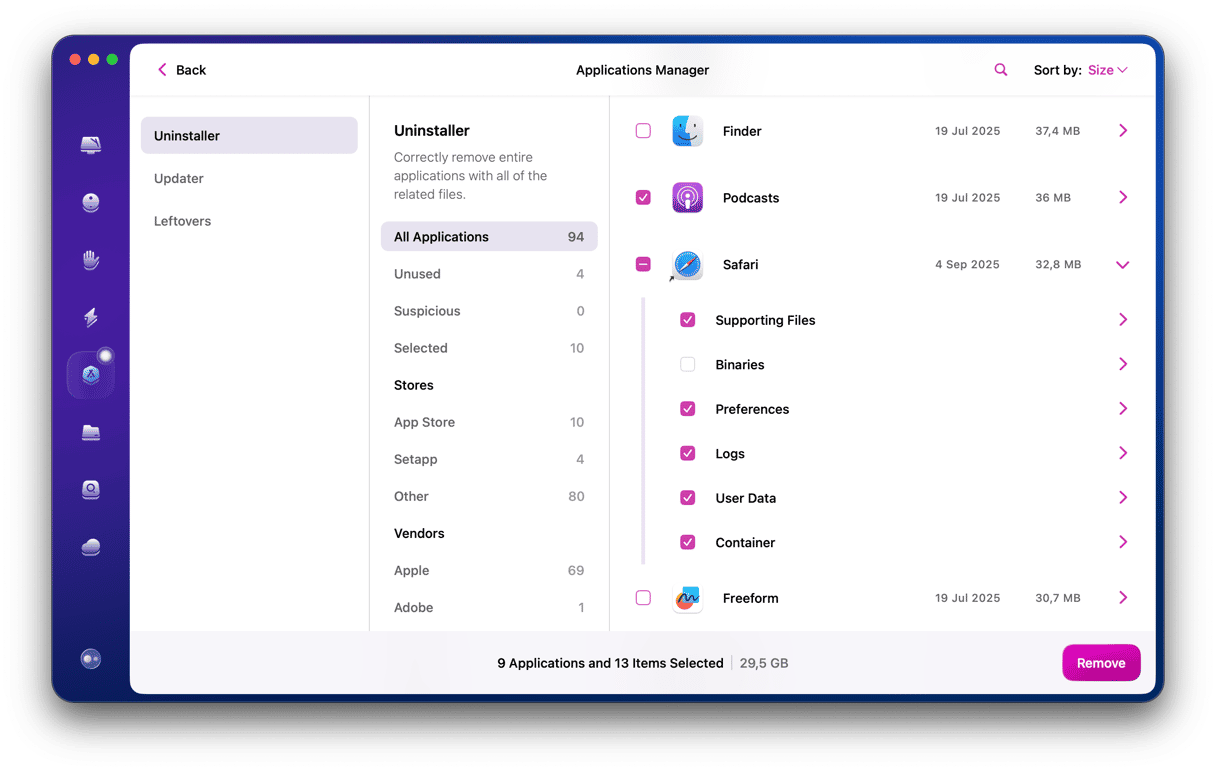
That’s it! Now, it’s time to test if the volume on Mac not working problem has been fixed.
8. Restart the sound controller
Mac sound not working still? If no apps interfere with your Mac’s sound output, nothing is plugged into the headphone jack, USB, or Thunderbolt ports, and your sound still doesn’t work, the next step is to restart the sound controller. This requires opening Activity Monitor and quitting a process, but don’t worry, it’s not too scary!
- Go to Applications > Utilities and double-click on Activity Monitor to open it.
- In the search bar, type ‘coreaudiod’ to locate the Core Audio controller.
- Click coreaudiod, then click ‘X’ in the toolbar to quit it.
- coreaudiod will restart.
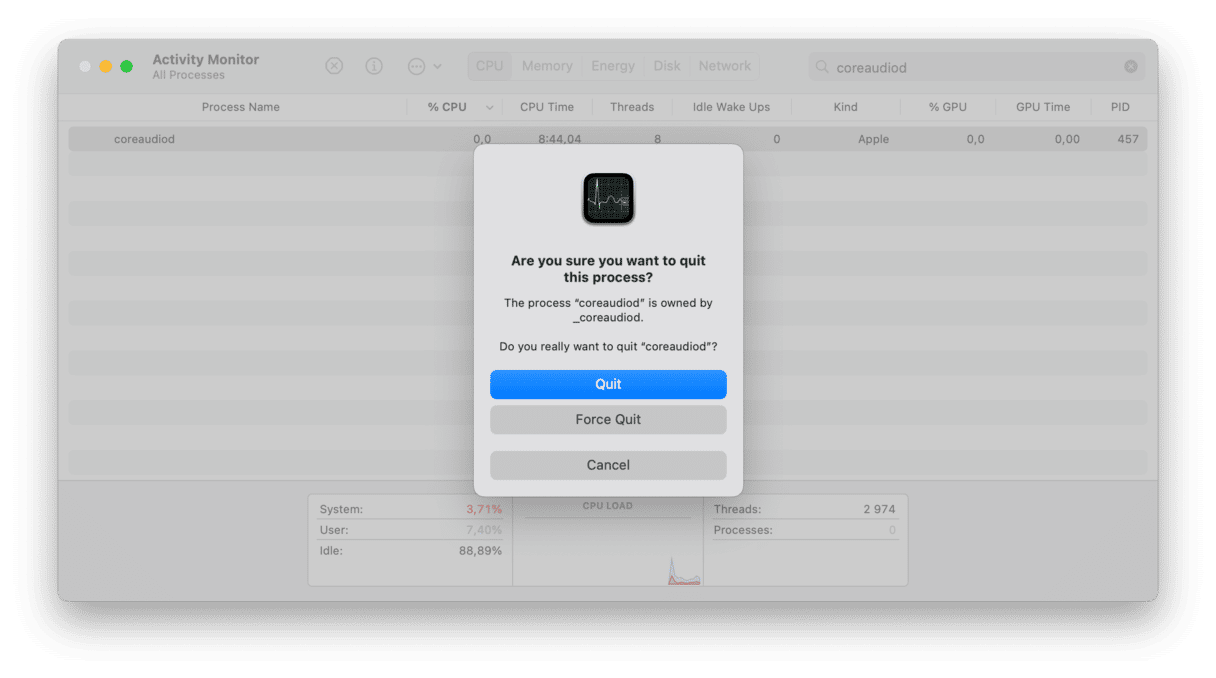
9. Make sure your headphones or speakers are connected
Sometimes, there may be no sound merely because the device is not connected. So, check it:
- Go to System Settings > Bluetooth.
- Look in the list of devices in the main window to see if your headphones or speakers are listed.
- If not, put them in pairing mode (you’ll need to refer to their instructions to find out how to do that), and when they appear, click Connect.
- If they are listed but not connected, make sure they’re switched on and Control-click on them in the main window and select Connect.
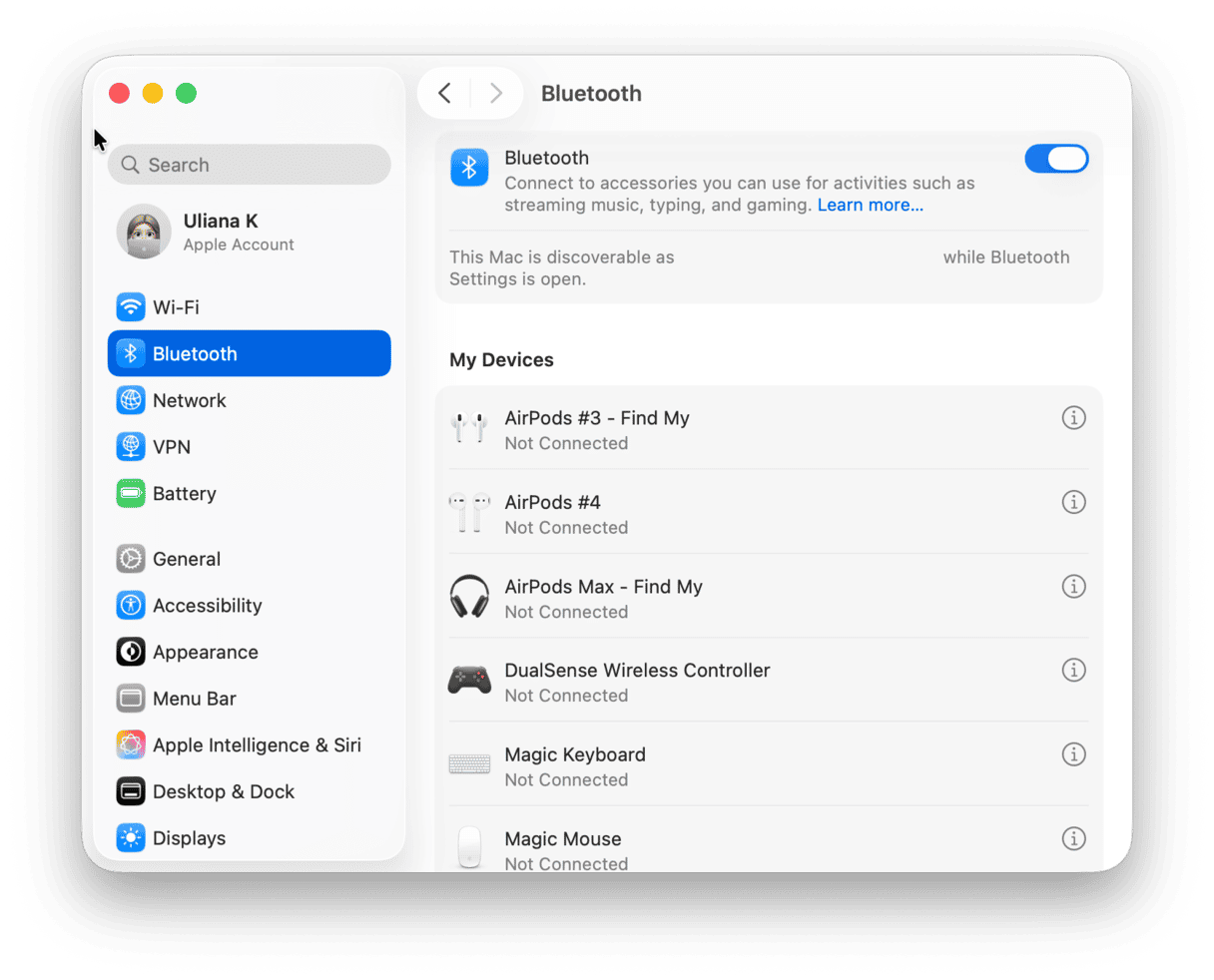
Tip: If you select the box labeled Show Bluetooth in the menu bar in Control Center settings, you can connect from the menu bar item.
Once your headphones or speakers are connected, click on the volume control in the menu bar and choose them. If you don’t have the volume control displayed on the menu bar, go to System Settings, choose Sound, and then the Output tab and select the Bluetooth speaker or headphones.
10. Reset NVRAM and SMC
If you’ve faced issues with the speaker volume on your Mac, it’s likely a software-related problem. Maybe some app conflicts with your speaker settings, or maybe there’s something else. The first thing you can do to troubleshoot the issue is to reset NVRAM/PRAM. These are small parts of your Mac’s memory that control sound volume, time zone, display resolution, and other settings on your Mac.

To reset NVRAM/PRAM, shut down your Mac, and press Option-Command-P-R on its startup. Release the keys after about 20 seconds. After your Mac restarts, check if the volume is back to normal. Note that these steps work only for Intel-based Macs, and there are no applicable steps for Macs with Apple silicon.
The second step is to reset SMC. It stands for System Management Controller, and it is responsible for different important physical aspects of your Mac, including sound. Steps differ for different Mac computers.
If the battery is removable:
- Turn off your Mac.
- Remove the battery.
- Press the power button and hold it for a few seconds.
- Reinstall the battery.
- Press the power button to turn on your Mac.
_1681290791.png)
If the battery is non-removable:
- Shut down your Mac.
- Press Shift+Control+Option on your keyboard and press the power button at the same time.
- Hold these keys for 10 seconds.
- Release the keys.
- Press the power button again to turn on your Mac.
_1681290802.png)
For iMac, Mac Pro, and Mac mini:
- Shut down your Mac.
- Unplug a power cord.
- Wait 15 seconds.
- Plug the power cord in.
- Wait several seconds and turn on your computer by pressing the power button.
If you have a Mac with Apple silicon, simply restart it.
To conclude, there are a number of reasons behind the sound not working on Mac issue. If you follow the guide above and take it one step at a time, you should be able to fix the problem. If none of the steps above work for you, the next step is to contact Apple support and, if possible, make an appointment at the Genius Bar of an Apple Store. Finally, it wouldn’t harm if you check your Mac for malware and remove system junk with the mentioned app, CleanMyMac. The basic system cleanup may help you to get your audio working again.
Frequently Asked Questions
1. Why did the sound stop working on my Mac?
There may be a number of reasons, including software and hardware issues. In most cases, it is muted or does not work in a specific app. In severe instances, it is a macOS glitch or a hardware failure.
2. What to do if the sound on my Mac is not working?
The very first thing to do is restart your Mac. Some other easy fixes include checking Sound preferences in System Settings and proper connection of an external device if you use one as well as double-checking volume. More sophisticated solutions are outlined above.
3. Why is my MacBook permanently muted?
It may be that the output source is not selected properly, or you have muted the output volume. Both can be checked in System Settings > Sound > Output.






